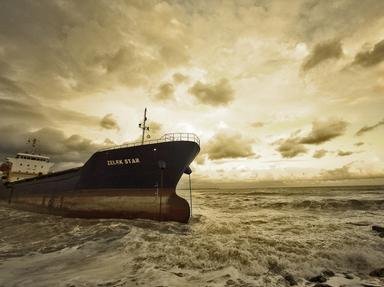Quiz Answer Key and Fun Facts
1. It's perhaps the most famous maritime mystery of all. Theories abound about what became of the crew of the 'Mary Celeste' before she was discovered abandoned in the North Atlantic in 1872, however what eventually became of the vessel?
2. Showing remarkable parallels with the mysterious abandonment of the Mary Celeste, this vessel was discovered aground off the coast of North Carolina in 1920 with no sign of the crew and the only life on board being two cats. What was her name?
3. Disasters at sea: Which of these ships sank with the greatest loss of life?
4. In the spring of 1918, the U.S. Navy suffered its largest single loss of life of WWI with the disappearance of a 10,000-ton fleet collier in the Caribbean. What was the name of the ship that shared a name with a figure from mythology?
5. Many ships have been lost to storms, but in 1782, one of the proudest ships in the Royal Navy sank in flat-calm waters while riding at anchor at Spithead. What was the name of the doomed ship that had been named after a British king?
6. "Women and children first" is the perceived priority when a ship starts to sink, but tragically, although 43 people survived the sinking of a ferry between Northern Ireland and Scotland in 1953, not a single woman or child was among them. With which of these royal princesses did she share a name?
7. December 13, 2007, marked the 100th anniversary of what is regarded as the world's first major oil spill. The vessel involved was the Thomas W. Lawson, but where in UK waters did she run aground?
8. Mishaps at sea: With what did the liner Olympic collide in May 1934?
9. "Your country needs you" was the tone of a familiar British recruiting poster during WWI, complete with the pointing finger and dramatic moustachioed image of Lord Kitchener. He was to die in in a naval disaster, but what was the name of the ship he was on?
10. "There's wild-eyed boy in the radio shack - he's the last remaining guest
He's tapping in a Morse code frenzy - please God, SOS"
These lines from the song 'Dance Band On the Titanic' by Harry Chapin are basically accurate, (allowing for some artistic licence). However, in 1912, British ships had not generally adopted SOS as a distress signal. What distress signal did they use?
Source: Author
darksplash
This quiz was reviewed by FunTrivia editor
trident before going online.
Any errors found in FunTrivia content are routinely corrected through our feedback system.

